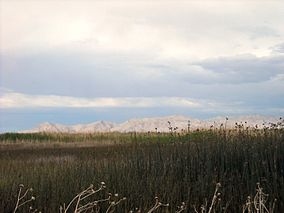Fish Springs National Wildlife Refuge
| Fish Springs National Wildlife Refuge | |
|---|---|
IUCN category IV (habitat/species management area) | |
 Marsh land at Fish Springs National Wildlife Refuge | |
| Location | Juab County, Utah, United States |
| Nearest city | Dugway, Utah |
| Coordinates | 39°51′29″N 113°22′01″W / 39.85806°N 113.36694°W |
| Area | 17,992 acres (7,281 ha) |
| Established | 1959 |
| Governing body | U.S. Fish and Wildlife Service |
| Website | Fish Springs National Wildlife Refuge |
Fish Springs National Wildlife Refuge is at the southern end of the Great Salt Lake Desert, part of the
cougars
and other native species.
The reserve can be reached by paved road from Lynndyl to Topaz Mountain and then by improved dirt road to the Pony Express Road/Lincoln Highway improved dirt road which runs through the Refuge. The Refuge also is a recreational area for permitted outdoor activities. The Fish Springs Range runs north to south and is immediately west of the Wildlife Refuge.[1]

Fish Springs started as a Pony Express and Overland Stage station, and got its name from the fish that populated the springs, which were reported to be over 6 inches (15 cm) in length.[2]
The fish are left over from ancient
permeable bedrock (for example, limestones) or faults toward Fish Springs.[3][failed verification] This comes from the fact the annual discharge of the springs is 27,500 acre-feet (33,900,000 m3)/year, and the annual recharge for the drainage area (the range front and Fish Springs Flat) is about 4,000 acre-feet (4,900,000 m3)/year, meaning over 6 times more water flows out of the springs than falls in the valley annually by precipitation. The springs and several wells in the area are monitored by Fish and Wildlife personnel and/or the Utah Geological Survey. The water of Fish Springs is not suited for human consumption, being warm (~80 °F (27 °C)) and highly saline.[4]
References
- ^ Fish Springs National Wildlife Refuge: Description, U.S. Fish and Wildlife Service, retrieved September 29, 2011
- ^
Van Cott, J. W. (1990), Utah Place Names, University of Utah Press, ISBN 978-0-87480-345-7
- ^
Basin and Range Carbonate-Rock Aquifer System Study, U.S. Geological Survey, retrieved September 29, 2011
- ^ The Utah Geological Survey's Snake Valley (and greater area) Ground Water Monitoring Program, archived from the original on November 3, 2010, retrieved September 29, 2011
External links
- Fish Springs National Wildlife Refuge: Homepage, U.S. Fish and Wildlife Service, retrieved June 18, 2016


